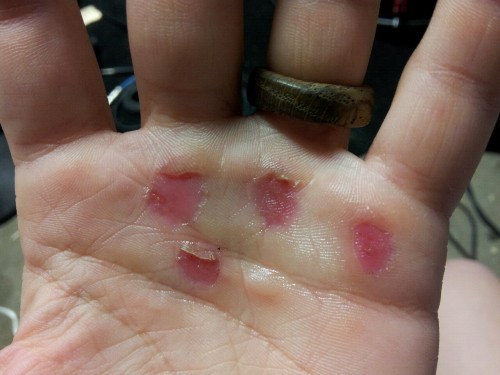keep it together.
Your body is an amazing system of systems. Your muscles, tissues, and tendons work to keep your bones and organs together. So every time you move your body searches for tension and stability in order to ‘hold it all together’. When we see people with broken bones, torn ligaments or muscles, this is an indication of body parts being loaded incorrectly with tremendous amounts of force or excessive amounts of repetitions.
Now with that,
there are things we can do help load our musculature in a more stability and
safe position. This is the basis for all
of the cues we use while working out. We
can translate these cues to everything you do in life by understanding a few
simple concepts.
One joint rule. Kstar (Kelly Starret of Mobilitywod.com), aka
the guy who has given the Crossfit world all the torture techniques you see in
the gym, developed the concept of the one joint rule. The idea is that we can look at our Shoulders
and Hips as the primary engines for movement in our body. They work similarly enough that if you can
understand one, you understand the other.
Additionally, the supporting engines associated with each joint, or
primary engine, are successive through the limbs. This means that we can look at our upper arm the same way we
look at our femur. The elbow is the
knee, the forearm is the shin, ankles are your wrists, and your hands are the
same as your feet. As with the bones,
the musculature is similarly associated.
Because our
primary engines are joints, their stability is founded by internal and external
rotation as it relates to extension and flexion. The hip works opposite of the shoulders.
Hip Stability = Flexion + external rotation, and Extension + Internal Rotation
The leopard. On the left, no bueno. On the right, flexion and external rotation at the hip.
Split Jerk. Right leg is extended and internally rotated. lookin' cool.
Shoulder Stability = Flexion + internal Rotation, and
Extension + external rotation.
The guy on the left has legit external rotation and extension of the shoulder. Guy on the right has some mobility issues.
Internal rotation and flexion at the shoulder is good, but she needs to rotate her hands more forward at the top position to achieve full external rotation while her arms are extended.
So if we can
understand how to stabilize our hips and shoulders, we can develop movement
patterns that put us in an optimal position.
The movements you see in crossfit already have these mapped out, and
with that, we have developed cues to get you into those positions without
having to understand why. For example,
saying ‘knees out’ when you are squatting is a lot easier to say and understand
than ‘externally rotate your femur as you flex your hip to descend your torso
towards the floor’. (the knees out cue has been beat to death, I know. When your knee starts to wobble inward on a squat, the cue knees out is meant to bring the athlete's knee back to neutral and in line with the shin)
Now let’s tie in
what you know about the one joint rule with stability. When I put my hip into flexion (squat), I
know that I need to maintain as vertical a shin as possible. Similarly, I can conclude that when I put my
shoulder into flexion (pushup), my forearm needs to remain as vertical as
possible as well. I also want my feet
generally straight during the squat (generally meaning pointing slightly outward), so I want my hands generally straight
during the pushup. Because I understand that my knees are like my elbows, and I also understand the rotation and stability of each joint, I know that I need to press my knees out during the squat and my elbows in as I decend into the pushup in order to keep the joints in line with the shin and forearm, respectively.
Like I said
earlier, its important to understand this concept because your coaches can only
make you drink the water while you are in the gym. The more we translate these movement patterns
into everyday life activities, the better chance you have of internalizing and
performing them without even thinking.
So when you pick up your granddaughter, your movement pattern should
look like a dead lift. When you go to
sit in a chair, it should look the same as beginning a squat. When you shoot a basketball, it should look
like a wall ball/push press. We can also use these concepts to develop stable positions when we are challenged with an unfamiliar movement. So if I want to go surfing for example, before I catch my first wave I already know how to make myself as stable as possible. Paddling out looks like internal rotation of the shoulder. Going from paddling a board to standing up looks like a burpee. When I bend at the hip, I need to prevent my knees from collapsing in in order to stay balanced.


















